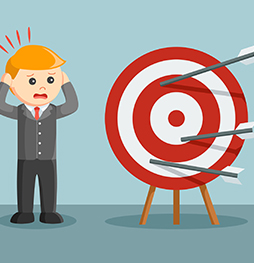My four-and-a half-year-old daughter reads her favorite chapters from Judy Blume’s Superfudge, filled with the antics of Fudge Hatcher. What interests me is how she learns as she reads. She struggles with a word and tries pronouncing it, not worried if it’s wrong. She asks me what a word means or what’s going on if she doesn’t understand something. She takes risks, and she doesn’t worry about the consequences.
However, she’s in kindergarten. When will she begin worrying about having the wrong answer? Hesitating before raising her hand because she’s not sure she has the right answer or the best answer? When will she stop taking these risks? And how can I encourage her to never worry about being wrong or asking questions? I’d like to learn the answers to these questions not just for her but because it would make me a better leader.
Systemic Issues
At some point in our educational system, we slowly “mold” the creativity, risk-taking behavior, and general “try and fail” learning style of children into a fear of failure. We focus on what a child did wrong instead of what they did right. We focus on and put the ultimate reward in the final product instead of the process.
Once we begin grading, feedback on an English paper typically notes all the misspellings, poor grammar, and poor structure. Generally, what gets addressed is why the paper has not lived up to expectations. What if teachers began by pointing out the great choice of words, the brilliant creativity, the flow of ideas instead? What if they closed their comments indicating how impressed they were with the topic the student tackled? The maturity with which they addressed it? Pointing out and reinforcing what someone did well is just as important as noting what could be done better.
We’re taught to put our heads down and not speak out or stand out. Don’t challenge the teacher. Don’t challenge the principal.
It’s rare for teachers in overcrowded classrooms to have time for kids who do things differently. The system can’t handle a child who challenges the status quo. We can’t even place children at the levels where they might belong, rather, we restrict them based on their age and assume they’re learning at the same level across every discipline. We tell them what is appropriate for them to be doing and rarely challenge them to go beyond the set curriculum.
Those who excel have pleased the teachers. They’ve learned what they’re supposed to learn and regurgitated it (or sometimes applied it) in the manner the school has set forth as appropriate. They’ve colored in the lines.
Why am I so focused on education? Because some of the biggest problems in corporate America begin with education.
Lack of Creativity in Corporate
Do you want employees who only color in the lines with the crayons or markers you’ve provided? What do they add to your organization? As more and more repetitive processes in business become automated, is someone who can complete those repetitive tasks, without question, really valuable?
Our educational system has failed our workers, our businesses, our ability to innovate, and our ability to be truly competitive. It hasn’t taught the traditional student to think beyond the instructions and tools they’re given. How do you change the mindset and reinvigorate the creativity of people who have spent years learning to conform to an educational system and likely a corporate environment? It’s evidence enough that professional development programs teach “critical thinking skills”; why aren’t our children being challenged with critical thinking, design thinking, and creative thinking all along?
Changing the Mindset in Your Organization
Even when a company says it wants to celebrate failure, does it really change the rules?
To expect an entire organization of individuals to “unlearn” decades of indoctrination is unrealistic.
So, where do you start? Plenty of approaches exist. Here are some options to consider as you begin the process.
- Rethink who you hire.
Diversity in thought is not limited to the groups du jour. Are you thinking about people from common geographic locations? Similar academic backgrounds? Similar professional backgrounds? Similar upbringings or cultures?
Take some risks in your hiring practices. Who has significant pursuits outside of their work life, such as music, magic, other hobbies? Who has continued their learning in a different fashion? New languages? Cooking? What skills would someone develop in the military or as an athlete?
If your industry/required skill set is steeped in rules, who can you hire that excels at breaking rules? Who has been disruptive (ideally, in a constructive way)? If your field is more creative, who can bring structure?
Aside from specific licensing required to perform specific types of work, do you weed out new hires by degrees? Why? Does that practice serve any purpose? Some of the most successful people in business today dropped out of traditional degree programs. Some of the most creative people have remained creative because their lives necessitated they think beyond coloring in the lines. Typically, their resumes will not showcase traditional and standard requirements. - Be honest about removing systems working against new and creative ideas.
Proposals may face many barriers even when they come from “the top.” Eliminate the “no” people; create “yes” ambassadors and ensure everyone has access to them and feels comfortable approaching them directly.
One of the best guidelines for the people working on innovative pursuits inside a more rigid organization is “excuse them from the rules.” Too often, companies may announce that new ideas, innovation, creativity is important, but reviews, bonuses, promotions, and raises are based on new business development, billable hours, deliverables, and/or other traditional measurements. Make sure traditional expectations change, are communicated, and used.
Finally, don’t make the only reward for someone who takes risks job retention. Don’t just plan launch parties, have a celebration when a project receives a red light. Celebrate the failure, literally: promote the lessons learned; apply these lessons; provide the individuals who led the failed initiative another high-profile project to lead. Demonstrate, in a very real and visible manner, you are celebrating the failure. - Reactivate and reengage people’s minds to think differently.
Like some companies, you may want to encourage (and reimburse) your people to investigate their creative side: take classes, pursue hobbies, and especially, learn a new instrument. But, pursuits outside of work time can be difficult to dictate.
If you really want to see your team in action, take off the pressure. doing so can manifest in different ways. First, play — from brain teasers and puzzles to actual games. Make sure people’s minds are working and operating differently, thinking about and processing things that don’t relate to everyday work. The experience doesn’t always need to tie back to corporate lessons (but it may help build camaraderie and better internal conflict resolution without any prompts).
When you’re ready to move past the games, a second option might prove useful: brainstorming for the “worst” ideas encourages people to participate. They’re no longer under the same pressure. When the goal is to generate bad ideas, they’re not going to be hesitant or worried about coming up with a good (or the best) idea.
Ironically, these approaches can achieve other goals — aligning and building teams with humor, taking a break, agreeing on the absolute worst ideas, and even creating consensus around what they don’t want to do. (And, there are times when playing with some of these bad ideas may lead to something pretty good.)
So what?
In the end, if all you really do is celebrate failure, you’re doing a lot more than you’d expect. You’re promoting resilience and perseverance; you’re bringing back an incredible piece of optimism from childhood. Building this mindset throughout an organization can be infinitely valuable.



